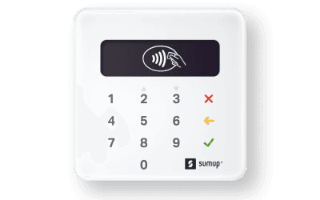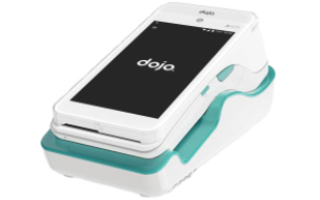Card payment devices are becoming an ever growing necessity for businesses around the world and if there is one thing a global pandemic taught us, it is that we are definitely living in an increasingly cashless society. In this guide, we take a look at 2 of the most popular card reader providers in the UK.
SumUp vs Dojo: provider overview
Both Dojo and SumUp are offering their customers cost-effective products with very different approaches.
SumUp is arguably one of the more well known card reader retailers on the market and, although Dojo has only been on the scene for a few years, it’s owned by payment giant PaymentSense and is slowly but surely making its way up.
In this guide, we are comparing their 2 most popular machines, the SumUp Air and the Dojo Go.

| Products | SumUp Air, SumUp Air and Cradle, SumUp Solo, SumUp 3G and Printer |
|---|---|
| Payment methods | Contactless, Chip and Pin |
| Alternative payment methods | QR code,Payment link |
| Apple Pay | Yes |
| Google Pay | Yes |
| Connectivity | Bluetooth |
| Requires connection to a phone or tablet | Yes |
| Battery life | 500 sales on a full charge |
| Warranty period | 12 months |

| Products | Dojo Go, Dojo One |
|---|---|
| Payment methods | Contactless, Chip and Pin, Magnetic swipe |
| Alternative payment methods | Payment link |
| Apple Pay | Yes |
| Google Pay | Yes |
| Connectivity | SIM card,WiFi |
| Requires connection to a phone or tablet | No |
| Battery life | 10 hours |
The SumUp Air vs the Dojo Go: product overview
Although both card reader providers offer other machines, the SumUp Air and the Dojo Go are the most comparable for SMEs.

SumUp Air

Dojo go
Compare rates and fees
Card machines feature a range of fees, use our guide for further explanations of the different charges you might come across in your research.
Depending on your business’s needs, you may feel more connected to one product over the other when it comes to contracts. SumUp is offering a one-off fee for the SumUp Air, whereas the Dojo Go will cost you a continuous monthly fee until your contract ends. Ultimately, this means that the more cost efficient machine is the SumUp Air. However, when you throw in transaction fees, Dojo is slightly more competitive (depending on the amount and type of sales).
When it comes to payout times, aka when you’ll hear the cha-ching in your business’s bank account, SumUp has a current settlement period of 1-3 days, whereas Dojo states that it will payout by 10am the next business day.
Compare features
Card machines usually come with a range of features, some of these will be the selling point for you and your business, and others you could take or leave. Use our guide to learn some of the most common features card readers come with.
So, what features can you expect with the Dojo Go and SumUp Air? When considering what payment types these readers take, there isn’t much of a difference. However, quickly jumping back to the fees and costs, depending on the payment method e.g. if the card is an Amex or a business card, you can expect to pay a higher fee with the Dojo Go.
Another thing to consider is the size difference between these two machines. The SumUp products are iconically pocket-sized and lightweight, whereas the Dojo Go is a slightly larger and heavier device. Both are great options, but if you will be taking payments on-the-go or if the device will be docked at a till really will be a deciding factor to which machine will work better for your business.
Bottom line
So, bottom line, which payment machine comes out on top? As always, it really does depend on what you will be using the reader for and both SumUp and Dojo offer products on the different ends of the spectrum. To compare all the products in full, you can use our table below.
Compare the SumUp and Dojo range
More guides on Finder
-
Compare the best mobile card readers
Learn more about how a mobile card reader could benefit your business.
-
Compare the best portable card machines
Discover more about how portable card machines work and whether they are right for your business.
-
Compare virtual terminals 2025
If your business needs to take payments over the phone or by email, a virtual terminal could provide the perfect solution.
-
Card machine fees and charges
We take a closer look at the different fees you face when you get a card machine for your business.
-
Compare myPOS card readers
Learn more about how myPOS card readers work.
-
Compare Stripe card readers
We compare Stripe’s full card reader range.
-
Compare Dojo card readers
Shorter contracts and affordable fees, start comparing Dojo Card readers for your business.
-
Compare takepayments card readers
Learn more about takepayments card readers to see if they are a good fit for your business
-
Compare SumUp card readers
In need of a card reader for your business and not sure where to start? Check out our review on the SumUp card machines.
-
Compare Square card readers
Find out how Square card readers work to see if they are right for you and your business.
